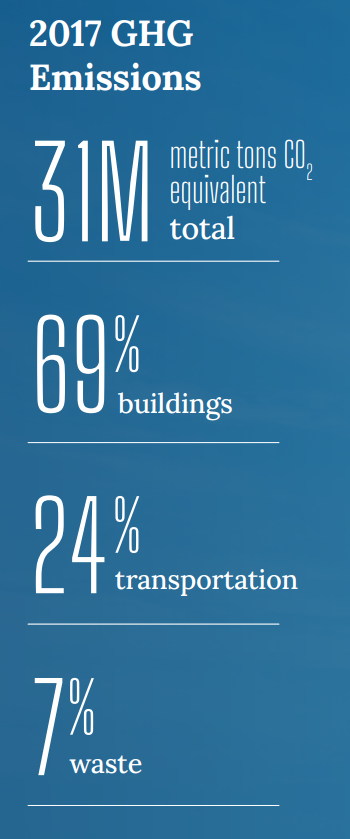Electrify Chicago
An independent tool for viewing City of Chicago building data
According to the
2022 Chicago Climate Action Plan,
69% of Chicago's emissions come from buildings, making
building emissions our biggest challenge and our biggest opportunity as a city
to tackle climate change. At Electrify Chicago, we showcase building performance using
publicly available data supplemented by community-submitted photographs and building
owners.
Start by looking at Chicago's buildings with the highest greenhouse gas intensity i.e. emissions per square foot. Large, efficient, buildings can perform much better than very inefficient small buildings on this metric.
New Article
📰 $30 Million In Missed Fines
The City Of Chicago failed to collect $30 million in potential fines from the building benchmarking ordinance, reducing transparency and accountability.
Legislative update! 🎉
As of late January 2024, legislation is being introduced to require new use more efficient forms of water and space heating, via the Clean And Affordable Buildings Ordinance (CABO), which will reduce the number of highly polluting and inefficient buildings that end up on this site.
If you're in Chicago,
write to your alderman to support the CABO!
Chicago Buildings by Greenhouse Gas Intensity
Note: Data includes large Chicago buildings with data from 2022, unless explicitly stated otherwise.
Note: This data only includes buildings whose emissions are reported
under the
Chicago Energy Benchmarking Ordinance. According to the City “As of 2016,
this list includes all commercial, institutional, and residential buildings larger than
50,000 square feet.” This dataset is also then filtered to only buildings with
reported emissions > 1,000 metric tons CO2 equivalent.
The latest year of data is from 2022, but we update the site regularly when new data is available, and some buildings may have failed to report that year, and only have older data available.
| Property Name / address | Primary Property Type |
Greenhouse Gas Intensity (kg CO2 eq./sqft) |
Total Greenhouse Emissions (metric tons CO2 eq.) |
|---|---|---|---|
|
Fort Dearborn Elementary -CPS
(CPS)
9001 S Throop St
| K-12 School | 5.7 kg/sqft
Lowest 37%
| 472 tons
Lowest 23%
|
|
Otis Elementary -CPS
🕰️
(CPS)
525 N Armour St
| K-12 School | 5.7 kg/sqft | 539 tons |
|
Nixon -CPS
(CPS)
2121 N Keeler Ave
| K-12 School | 5.7 kg/sqft
Lowest 37%
| 736 tons
Lowest 42%
|
|
Reilly Es -CPS
(CPS)
3650 W School St
| K-12 School | 5.7 kg/sqft
Lowest 37%
| 654 tons
Lowest 37%
|
|
Mark Skinner Elementary -CPS
(CPS)
111 S Throop St
| K-12 School | 5.7 kg/sqft
Lowest 37%
| 859 tons
Lowest 49%
|
|
Coonley, John C -CPS
(CPS)
4046 N Leavitt St
| K-12 School | 5.7 kg/sqft
Lowest 37%
| 609 tons
Lowest 34%
|
|
Chavez, Cesar E Multicultural Academic Center Es -CPS
(CPS)
4747 S Marshfield Ave
| K-12 School | 5.7 kg/sqft
Lowest 37%
| 553 tons
Lowest 30%
|
|
Stockton Specialty, Joseph -CPS
🕰️
(CPS)
4420 N Beacon St
| K-12 School | 5.7 kg/sqft | 639 tons |
|
Marsh Elementary -CPS
(CPS)
9804 S Exchange
| K-12 School | 5.7 kg/sqft
Lowest 37%
| 806 tons
Lowest 46%
|
|
1448 Lake Shore Dr
1448 N Lake Shore Dr
| Multifamily Housing | 5.7 kg/sqft
Lowest 37%
| 996 tons
Highest 45%
|
|
Jones College Prep, William - CPS
(CPS)
600 S State St
| K-12 School | 5.7 kg/sqft
Lowest 37%
| 2,195 tons
Highest 21%
|
|
The Private Residences of Ritchie Court
1313 N Ritchie Ct
| Multifamily Housing | 5.7 kg/sqft
Lowest 37%
| 1,109 tons
Highest 42%
|
|
Lakeside on the Park Condominium
1250 S INDIANA AVE
| Multifamily Housing | 5.7 kg/sqft
Lowest 37%
| 1,177 tons
Highest 40%
|
|
801 South Plymouth Condo Association
801 S Plymouth Ct
| Multifamily Housing | 5.7 kg/sqft
Lowest 37%
| 1,434 tons
Highest 33%
|
|
Lake Point Tower
505 N Lake Shore Dr
| Multifamily Housing | 5.7 kg/sqft
Lowest 37%
| 8,908 tons
Highest 3%
|
Data Source:
Chicago Energy Benchmarking Data
